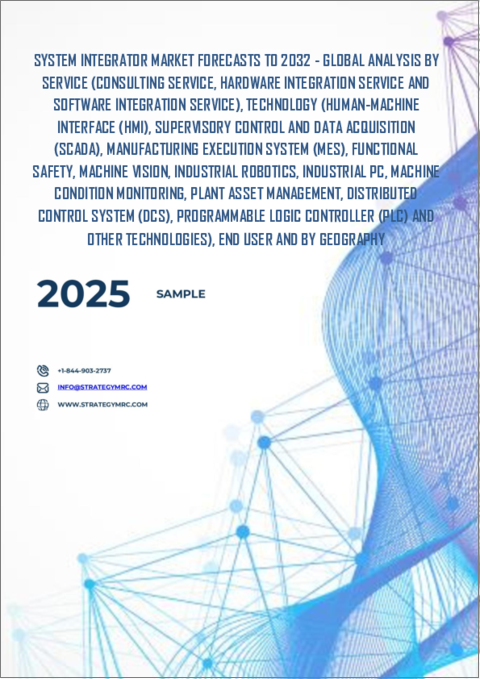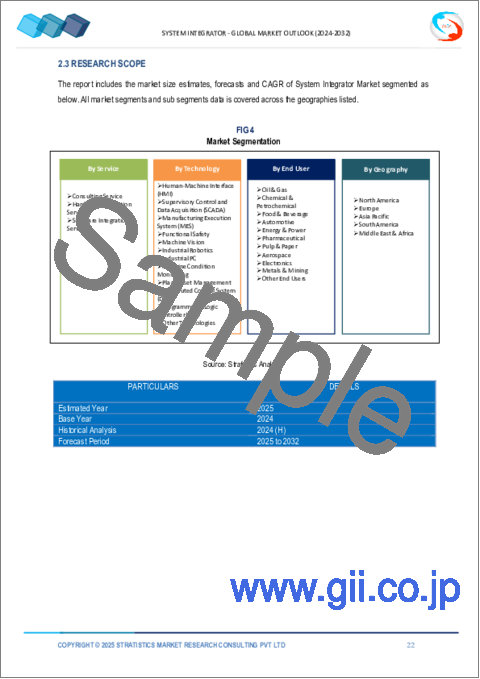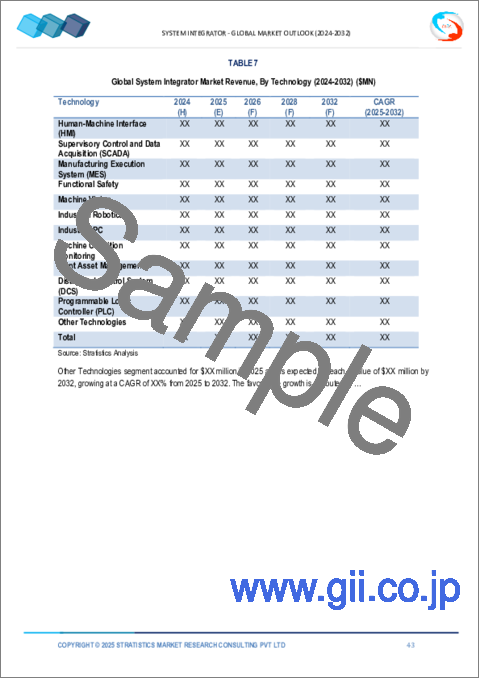|
|
市場調査レポート
商品コード
1476345
システムインテグレーター市場の2030年までの予測: サービス別、技術別、エンドユーザー別、地域別の世界分析System Integrator Market Forecasts to 2030 - Global Analysis By Service, Technology, End User and by Geography |
||||||
カスタマイズ可能
|
|||||||
| システムインテグレーター市場の2030年までの予測: サービス別、技術別、エンドユーザー別、地域別の世界分析 |
|
出版日: 2024年05月05日
発行: Stratistics Market Research Consulting
ページ情報: 英文 200+ Pages
納期: 2~3営業日
|
全表示
- 概要
- 図表
- 目次
Stratistics MRCによると、世界のシステムインテグレーター市場は2023年に284億7,000万米ドルを占め、2030年までにCAGR8.3%で成長し、497億4,000万米ドルに達すると予測されています。
システムインテグレーターは、異種のハードウェアやソフトウェアコンポーネントを融合させ、特定のビジネス要件に対応する一貫したシステムを構築する専門家です。さらに、これらの専門家は、異種の技術プラットフォーム間のリンクを提供し、円滑な通信と運用を保証します。彼らの専門は、ソフトウェア・プログラムからネットワーク・インフラに至るまで、様々なシステムを理解し、それらを巧みに統合して効率を最大化し、ワークフローを簡素化することです。
国際システム・インテグレーション協会(ISIA)によると、システム・インテグレーションとは、異なるコンピューティング・システムやソフトウェア・アプリケーションを物理的または機能的に接続し、調整された全体として機能させるプロセスです。
複雑化するIT環境
今日のビジネス環境を特徴づけているのは、膨大な数のテクノロジー、システム、アプリケーションです。合併や買収などの要因に加え、テクノロジーの発展スピードが速いため、組織のIT環境はより複雑になっています。これらの異種コンポーネントを管理・統合するには、専門的な知識と慎重な計画が必要です。システムインテグレーターは、異種のITシステムを接続し簡素化する包括的なソリューションを提供することで、この複雑な状況を乗り切るために不可欠な存在です。さらに、システムインテグレーターは、さまざまなテクノロジーの複雑性をナビゲートし、スムーズなプラットフォームの相互運用性とコミュニケーションを保証するために必要な専門知識と理解を備えています。
セキュリティとコンプライアンスの問題
システム統合プロジェクトでは、セキュリティとコンプライアンスに真剣に取り組まなければなりません。特に、機密データや法的要件が一般的なヘルスケア、金融、政府などの分野ではそうです。統合システムがサイバー攻撃から安全であること、業界標準を遵守していること、適用されるすべての法的要件を満たしていることを保証することは、システムインテグレーターの責任です。徹底的なリスク評価、セキュリティ管理、継続的な維持・監視が必要となるため、コンプライアンスを達成・維持することは困難です。また、セキュリティやコンプライアンスの問題が十分に解決されない場合、データ漏洩、当局からの罰金、評判の低下、法的影響などの可能性があるため、システム統合プロジェクトは大きな制約を受けることになります。
デジタルトランスフォーメーションプロジェクトの増加
プロセスの近代化、俊敏性の向上、イノベーションの促進を目指す組織は、デジタルトランスフォーメーションを重視し続けています。システムインテグレーターは、デジタル技術を活用することで、組織のビジネスプロセスの変革、顧客エンゲージメントの向上、競争力の獲得を支援することができます。さらに、システムインテグレーターは、こうしたイニシアチブをサポートするのに適した立場にあります。システムインテグレーターは、異種のシステムやプラットフォーム間のシームレスな統合と相互運用性を促進するために不可欠な存在であり、これにより業界を問わず顧客のデジタルトランスフォーメーション・イニシアチブを成功に導くことができます。彼らの仕事は、クラウドへの移行やデータ分析から、IoTの導入や自動化まで多岐にわたる。
激しい競争と価格圧力
システムインテグレーター市場では熾烈な競争が繰り広げられており、多くの企業が顧客との契約や市場シェアをめぐって争っています。顧客は投資を最大限に活用するため、より良い条件や低料金を求めて頻繁に駆け引きを行うため、こうした競争から価格圧力が生じる可能性があります。さらに競争を激化させているのは、大規模なテクノロジー企業の出現と、小規模でニッチなプレーヤーの成長です。さらに、価格圧力は、利益率を低下させ、事業運営の持続可能性に影響を与えることで、システムインテグレーターの存続と拡大を深刻に危うくする可能性があります。
COVID-19の影響:
システムインテグレーターの市場は、COVID-19の大流行によって大きな影響を受けており、これはチャンスと課題の両方を生み出しています。ロックダウンやサプライチェーンの寸断による初期の混乱がプロジェクトの実装を遅らせ、意思決定プロセスを遅らせたとはいえ、リモートワークやデジタル変革へのシフトの結果、システム統合サービスの需要は高まっています。さらに、企業は、リモート業務に適応し、デジタル能力を向上させなければならない結果、クラウド・コンピューティング、デジタル・インフラ、サイバーセキュリティ・ソリューション、コラボレーション・ツール、クラウド・コンピューティングへの投資を増やしています。
予測期間中、監視制御・データ収集(SCADA)セグメントが最大となる見込み
システムインテグレーター業界では、SCADA(Supervisory Control and Data Acquisition)分野が最大の市場シェアを占めると予測されています。SCADAシステムは、運輸、エネルギー、製造、公共事業を含む様々な産業における産業プロセスとインフラの監視と制御において重要な役割を果たしています。さらに、分散プロセスのリアルタイムデータ取得、可視化、制御はこれらのシステムによって可能となり、オペレータは生産性を最大化し、効率を改善し、安全を保証するために必要な知識を得ることができます。
予測期間中、エネルギー・電力分野のCAGRが最も高くなる見込み
システムインテグレーター市場では、エネルギー・電力分野のCAGRが最も高くなると予測されています。エネルギー・電力産業のサブセクターは多岐にわたり、再生可能エネルギー、送電、配電、発電などが含まれます。システムインテグレーターは、発電・配電プロセスの自動化、制御、監視、最適化のための完全なソリューションを提供するため、この業界にとって不可欠な存在です。さらに、エネルギー効率化、送電網の近代化、再生可能エネルギーの統合、スマートグリッドへの取り組みに対する需要の高まりから、エネルギー・電力部門はシステムインテグレーターに多くの機会を提供しています。
最大のシェアを占める地域
システムインテグレーター市場では、アジア太平洋地域が最大のシェアを占めることが多いです。中国、日本、インド、韓国、東南アジア諸国を含むアジア太平洋地域は、急速な工業化、都市化、経済成長を背景に、製造、インフラ、テクノロジーへの投資が莫大なものとなっています。このため、ヘルスケア、エレクトロニクス、製造、エネルギー、自動車産業など、多くの分野でシステム・インテグレーション・サービスのニーズが高まっています。さらに、インダストリー4.0構想、スマートシティプロジェクト、デジタル技術の採用拡大なども、この地域におけるシステムインテグレーション・ソリューションの需要に拍車をかけています。
CAGRが最も高い地域:
システムインテグレーター市場では、中東・アフリカ(MEA)地域が最も高いCAGRを維持すると予測されています。同地域におけるシステムインテグレーターサービスのニーズは、同地域の急速な工業化、都市化、製造業、建設業、公益事業、石油・ガスなどの産業にわたるインフラ開発イニシアチブによって高まっています。また、MEAのシステムインテグレーター市場の成長は、再生可能エネルギープロジェクト、スマートシティ構想、デジタル変革への投資が増加していることも後押ししています。さらに、経済の多様化、競合の増加、技術革新の促進を目的とした政府の取り組みによって、最先端技術の採用も後押しされています。これは、システムインテグレーターにとって、地域のビジネスや産業の変化するニーズに対応するカスタマイズソリューションを提供する大きなチャンスとなります。
無料のカスタマイズ提供:
本レポートをご購読のお客様には、以下の無料カスタマイズオプションのいずれかをご利用いただけます:
- 企業プロファイル
- 追加市場プレーヤーの包括的プロファイリング(3社まで)
- 主要企業のSWOT分析(3社まで)
- 地域セグメンテーション
- 顧客の関心に応じた主要国の市場推計・予測・CAGR(注:フィージビリティチェックによる)
- 競合ベンチマーキング
- 製品ポートフォリオ、地理的プレゼンス、戦略的提携に基づく主要企業のベンチマーキング
目次
第1章 エグゼクティブサマリー
第2章 序文
- 概要
- ステークホルダー
- 調査範囲
- 調査手法
- データマイニング
- データ分析
- データ検証
- 調査アプローチ
- 調査情報源
- 1次調査情報源
- 2次調査情報源
- 前提条件
第3章 市場動向分析
- 促進要因
- 抑制要因
- 機会
- 脅威
- 技術分析
- エンドユーザー分析
- 新興市場
- COVID-19の影響
第4章 ポーターのファイブフォース分析
- 供給企業の交渉力
- 買い手の交渉力
- 代替品の脅威
- 新規参入業者の脅威
- 競争企業間の敵対関係
第5章 世界のシステムインテグレーター市場:サービス別
- コンサルティングサービス
- ハードウェア統合サービス
- ソフトウェア統合サービス
第6章 世界のシステムインテグレーター市場:技術別
- ヒューマンマシンインターフェース(HMI)
- 監視制御およびデータ収集(SCADA)
- 製造実行システム(MES)
- 機能安全
- マシンビジョン
- 産業用ロボット
- 産業用PC
- 機械状態監視
- プラント資産管理
- 分散制御システム(DCS)
- プログラマブルロジックコントローラ(PLC)
- その他の技術
第7章 世界システムインテグレーター市場:エンドユーザー別
- 石油ガス
- 化学・石油化学
- 食品・飲料
- 自動車
- エネルギーと電力
- 製薬
- パルプ・紙
- 航空宇宙
- エレクトロニクス
- 金属・鉱業
- その他のエンドユーザー
第8章 世界のシステムインテグレーター市場:地域別
- 北米
- 米国
- カナダ
- メキシコ
- 欧州
- ドイツ
- 英国
- イタリア
- フランス
- スペイン
- その他の欧州
- アジア太平洋
- 日本
- 中国
- インド
- オーストラリア
- ニュージーランド
- 韓国
- その他のアジア太平洋
- 南米
- アルゼンチン
- ブラジル
- チリ
- その他の南米
- 中東・アフリカ
- サウジアラビア
- アラブ首長国連邦
- カタール
- 南アフリカ
- その他の中東・アフリカ
第9章 主な発展
- 契約、パートナーシップ、コラボレーション、合弁事業
- 買収と合併
- 新製品発売
- 事業拡大
- その他の主要戦略
第10章 企業プロファイリング
- HCL Technologies Limited
- IBM
- Accenture
- Capgemini
- John Wood Group PLC
- Maverick Technologies LLC
- ATS Corporation
- Prime Controls LP
- Tata Consultancy Services Limited
- BW Design Group
- JR Automation
- Infosys Limited
- Avanceon
- Cognizant
- Tesco Controls, Inc.
- Wipro
List of Tables
- Table 1 Global System Integrator Market Outlook, By Region (2021-2030) ($MN)
- Table 2 Global System Integrator Market Outlook, By Service (2021-2030) ($MN)
- Table 3 Global System Integrator Market Outlook, By Consulting Service (2021-2030) ($MN)
- Table 4 Global System Integrator Market Outlook, By Hardware Integration Service (2021-2030) ($MN)
- Table 5 Global System Integrator Market Outlook, By Software Integration Service (2021-2030) ($MN)
- Table 6 Global System Integrator Market Outlook, By Technology (2021-2030) ($MN)
- Table 7 Global System Integrator Market Outlook, By Human-Machine Interface (HMI) (2021-2030) ($MN)
- Table 8 Global System Integrator Market Outlook, By Supervisory Control and Data Acquisition (SCADA) (2021-2030) ($MN)
- Table 9 Global System Integrator Market Outlook, By Manufacturing Execution System (MES) (2021-2030) ($MN)
- Table 10 Global System Integrator Market Outlook, By Functional Safety (2021-2030) ($MN)
- Table 11 Global System Integrator Market Outlook, By Machine Vision (2021-2030) ($MN)
- Table 12 Global System Integrator Market Outlook, By Industrial Robotics (2021-2030) ($MN)
- Table 13 Global System Integrator Market Outlook, By Industrial PC (2021-2030) ($MN)
- Table 14 Global System Integrator Market Outlook, By Machine Condition Monitoring (2021-2030) ($MN)
- Table 15 Global System Integrator Market Outlook, By Plant Asset Management (2021-2030) ($MN)
- Table 16 Global System Integrator Market Outlook, By Distributed Control System (DCS) (2021-2030) ($MN)
- Table 17 Global System Integrator Market Outlook, By Programmable Logic Controller (PLC) (2021-2030) ($MN)
- Table 18 Global System Integrator Market Outlook, By Other Technologies (2021-2030) ($MN)
- Table 19 Global System Integrator Market Outlook, By End User (2021-2030) ($MN)
- Table 20 Global System Integrator Market Outlook, By Oil & Gas (2021-2030) ($MN)
- Table 21 Global System Integrator Market Outlook, By Chemical & Petrochemical (2021-2030) ($MN)
- Table 22 Global System Integrator Market Outlook, By Food & Beverage (2021-2030) ($MN)
- Table 23 Global System Integrator Market Outlook, By Automotive (2021-2030) ($MN)
- Table 24 Global System Integrator Market Outlook, By Energy & Power (2021-2030) ($MN)
- Table 25 Global System Integrator Market Outlook, By Pharmaceutical (2021-2030) ($MN)
- Table 26 Global System Integrator Market Outlook, By Pulp & Paper (2021-2030) ($MN)
- Table 27 Global System Integrator Market Outlook, By Aerospace (2021-2030) ($MN)
- Table 28 Global System Integrator Market Outlook, By Electronics (2021-2030) ($MN)
- Table 29 Global System Integrator Market Outlook, By Metals & Mining (2021-2030) ($MN)
- Table 30 Global System Integrator Market Outlook, By Other End Users (2021-2030) ($MN)
Note: Tables for North America, Europe, APAC, South America, and Middle East & Africa Regions are also represented in the same manner as above.
According to Stratistics MRC, the Global System Integrator Market is accounted for $28.47 billion in 2023 and is expected to reach $49.74 billion by 2030 growing at a CAGR of 8.3% during the forecast period. An essential member of the tech community, a system integrator specializes in fusing disparate hardware and software components together to create cohesive systems that address particular business requirements. Moreover, these experts provide a link between disparate technological platforms, guaranteeing smooth communication and operation. Their specialty comprehends various systems, ranging from software programs to networking infrastructures, and skilfully merging them to maximize efficiency and simplify workflows.
According to the International System Integration Association (ISIA), system integration is the process of connecting different computing systems and software applications physically or functionally to act as a coordinated whole.
Market Dynamics:
Driver:
Growing intricacy of IT environments
A profusion of technologies, systems, and applications characterizes today's business environment. Organizational IT environments are becoming more complex due to factors like mergers and acquisitions as well as the rapid speed at which technology is developing. It takes specialist knowledge and careful planning to manage and integrate these disparate components. By providing all-inclusive solutions that connect and simplify disparate IT systems, system integrators are essential in navigating this complexity. Furthermore, they are equipped with the expertise and understanding necessary to navigate the complexities of various technologies, guaranteeing smooth platform interoperability and communication.
Restraint:
Issues with security and compliance
System integration projects must take security and compliance very seriously, especially in sectors like healthcare, finance, and government where sensitive data and legal requirements are common. It is the responsibility of system integrators to guarantee that integrated systems are safe from cyber attacks, adhere to industry standards, and meet all applicable legal requirements. It can be difficult to achieve and maintain compliance, as it calls for thorough risk assessments, security controls, and continuous upkeep and monitoring. Additionally, system integration projects are severely constrained when security and compliance issues are not sufficiently addressed because of the potential for data breaches, fines from authorities, harm to one's reputation, and legal ramifications.
Opportunity:
Growth of digital transformation projects
Organizations looking to modernize their processes, increase agility, and spur innovation continue to place a high premium on digital transformation. System integrators can help organizations transform their business processes, improve customer engagement, and gain a competitive edge by leveraging digital technologies. Moreover, this puts them in a good position to support these initiatives. System integrators are essential to facilitating seamless integration and interoperability across disparate systems and platforms, which drives successful digital transformation initiatives for clients across industries. Their work ranges from cloud migration and data analytics to IoT deployment and automation.
Threat:
Fierce rivalry and pressure on prices
There is fierce competition in the system integrator market, with many companies fighting for client contracts and market share. Price pressure may result from this competition since customers frequently try to bargain for better conditions and lower rates in order to get the most out of their investments. Further escalating the competition are the emergence of larger technology firms and the growth of smaller, niche players, which makes it difficult for system integrators to set themselves apart solely on the basis of price. Additionally, price pressures can seriously jeopardize the viability and expansion of system integrators by eroding profit margins and affecting the sustainability of business operations.
Covid-19 Impact:
The market for system integrators has been significantly impacted by the COVID-19 pandemic, which has created both opportunities and challenges. System integration services have become more in demand as a result of the shift towards remote work and digital transformation, even though the initial disruptions caused by lockdowns and supply chain disruptions slowed project implementations and delayed decision-making processes. Furthermore, companies have increased their investments in cloud computing, digital infrastructure, cybersecurity solutions, collaboration tools, and cloud computing as a result of having to adjust to remote operations and improve digital capabilities.
The Supervisory Control and Data Acquisition (SCADA) segment is expected to be the largest during the forecast period
It is projected that the Supervisory Control and Data Acquisition (SCADA) segment will command the largest market share in the system integrator industry. SCADA systems play a crucial role in the monitoring and control of industrial processes and infrastructure in a variety of industries, including transportation, energy, manufacturing, and utilities. Moreover, real-time data acquisition, visualization, and control of distributed processes are made possible by these systems, giving operators the knowledge they need to maximize productivity, improve efficiency, and guarantee safety.
The Energy & Power segment is expected to have the highest CAGR during the forecast period
In the system integrator market, the energy and power segment is projected to have the highest CAGR. The sub-sectors of the energy and power industry are diverse and include renewable energy, transmission, distribution, and electricity generation. Because they offer complete solutions for the automation, control, monitoring, and optimization of power generation and distribution processes, system integrators are essential to this industry. Additionally, the energy and power sector offers system integrators a lot of opportunities because of the growing demand for energy efficiency, grid modernization, integration of renewable energy, and smart grid initiatives.
Region with largest share:
In the market for system integrators, the Asia-Pacific region frequently holds the largest share. The Asia-Pacific region, which includes China, Japan, India, South Korea, and Southeast Asian countries, has experienced tremendous investments in manufacturing, infrastructure, and technology due to their fast industrialization, urbanization, and economic growth. This has increased the need for system integration services in a number of sectors, including healthcare, electronics, manufacturing, energy, and the automotive industry. Furthermore, the demand for system integration solutions in the area is also fueled by Industry 4.0 initiatives, smart city projects, and the growing adoption of digital technologies.
Region with highest CAGR:
In the system integrator market, the Middle East and Africa (MEA) region is anticipated to hold the highest CAGR. The need for system integration services in the region is being driven by the region's rapid industrialization, urbanization, and infrastructure development initiatives across industries like manufacturing, construction, utilities, oil and gas, and oil and gas. The growth of the system integrator market in MEA is also aided by rising investments in renewable energy projects, smart city initiatives, and digital transformation. Moreover, the adoption of cutting-edge technologies is also being encouraged by government initiatives to diversify economies, increase competitiveness, and promote innovation. This presents a significant opportunity for system integrators to offer customized solutions to meet the changing needs of regional businesses and industries.
Key players in the market
Some of the key players in System Integrator market include HCL Technologies Limited, IBM, Accenture, Capgemini, John Wood Group PLC, Maverick Technologies LLC, ATS Corporation, Prime Controls LP, Tata Consultancy Services Limited, BW Design Group, JR Automation, Infosys Limited, Avanceon, Cognizant, Tesco Controls, Inc. and Wipro.
Key Developments:
In December 2023, HCL Tech has signed a five-year agreement with Swedish manufacturer Husqvarna Group for a strategic digital transformation partnership through artificial intelligence (AI)-based solutions and, the Indian IT services company. In a major milestone for HCLTech, this is the first time a large global IT contract by an India- headquartered technology company has been vested certified.
In November 2023, IBM and Riyadh Air announced the signing of a strategic agreement in which IBM Consulting will be the lead systems integrator to support creating, building and orchestrating the technology foundation that can help the digitally native airline offer exceptional and seamless travel experiences.
In May 2023, Accenture Federal Services has won a spot on a seven-year purchase agreement worth up to $2.6 billion in contracts to modernize IRS systems. The agreement covers 400 IRS systems, the company said Wednesday in a statement. Accenture will help the IRS develop new ways for taxpayers and tax professionals to interact with the agency.
Services Covered:
- Consulting Service
- Hardware Integration Service
- Software Integration Service
Technologies Covered:
- Human-Machine Interface (HMI)
- Supervisory Control and Data Acquisition (SCADA)
- Manufacturing Execution System (MES)
- Functional Safety
- Machine Vision
- Industrial Robotics
- Industrial PC
- Machine Condition Monitoring
- Plant Asset Management
- Distributed Control System (DCS)
- Programmable Logic Controller (PLC)
- Other Technologies
End Users Covered:
- Oil & Gas
- Chemical & Petrochemical
- Food & Beverage
- Automotive
- Energy & Power
- Pharmaceutical
- Pulp & Paper
- Aerospace
- Electronics
- Metals & Mining
- Other End Users
Regions Covered:
- North America
- US
- Canada
- Mexico
- Europe
- Germany
- UK
- Italy
- France
- Spain
- Rest of Europe
- Asia Pacific
- Japan
- China
- India
- Australia
- New Zealand
- South Korea
- Rest of Asia Pacific
- South America
- Argentina
- Brazil
- Chile
- Rest of South America
- Middle East & Africa
- Saudi Arabia
- UAE
- Qatar
- South Africa
- Rest of Middle East & Africa
What our report offers:
- Market share assessments for the regional and country-level segments
- Strategic recommendations for the new entrants
- Covers Market data for the years 2021, 2022, 2023, 2026, and 2030
- Market Trends (Drivers, Constraints, Opportunities, Threats, Challenges, Investment Opportunities, and recommendations)
- Strategic recommendations in key business segments based on the market estimations
- Competitive landscaping mapping the key common trends
- Company profiling with detailed strategies, financials, and recent developments
- Supply chain trends mapping the latest technological advancements
Free Customization Offerings:
All the customers of this report will be entitled to receive one of the following free customization options:
- Company Profiling
- Comprehensive profiling of additional market players (up to 3)
- SWOT Analysis of key players (up to 3)
- Regional Segmentation
- Market estimations, Forecasts and CAGR of any prominent country as per the client's interest (Note: Depends on feasibility check)
- Competitive Benchmarking
- Benchmarking of key players based on product portfolio, geographical presence, and strategic alliances
Table of Contents
1 Executive Summary
2 Preface
- 2.1 Abstract
- 2.2 Stake Holders
- 2.3 Research Scope
- 2.4 Research Methodology
- 2.4.1 Data Mining
- 2.4.2 Data Analysis
- 2.4.3 Data Validation
- 2.4.4 Research Approach
- 2.5 Research Sources
- 2.5.1 Primary Research Sources
- 2.5.2 Secondary Research Sources
- 2.5.3 Assumptions
3 Market Trend Analysis
- 3.1 Introduction
- 3.2 Drivers
- 3.3 Restraints
- 3.4 Opportunities
- 3.5 Threats
- 3.6 Technology Analysis
- 3.7 End User Analysis
- 3.8 Emerging Markets
- 3.9 Impact of Covid-19
4 Porters Five Force Analysis
- 4.1 Bargaining power of suppliers
- 4.2 Bargaining power of buyers
- 4.3 Threat of substitutes
- 4.4 Threat of new entrants
- 4.5 Competitive rivalry
5 Global System Integrator Market, By Service
- 5.1 Introduction
- 5.2 Consulting Service
- 5.3 Hardware Integration Service
- 5.4 Software Integration Service
6 Global System Integrator Market, By Technology
- 6.1 Introduction
- 6.2 Human-Machine Interface (HMI)
- 6.3 Supervisory Control and Data Acquisition (SCADA)
- 6.4 Manufacturing Execution System (MES)
- 6.5 Functional Safety
- 6.6 Machine Vision
- 6.7 Industrial Robotics
- 6.8 Industrial PC
- 6.9 Machine Condition Monitoring
- 6.10 Plant Asset Management
- 6.11 Distributed Control System (DCS)
- 6.12 Programmable Logic Controller (PLC)
- 6.13 Other Technologies
7 Global System Integrator Market, By End User
- 7.1 Introduction
- 7.2 Oil & Gas
- 7.3 Chemical & Petrochemical
- 7.4 Food & Beverage
- 7.5 Automotive
- 7.6 Energy & Power
- 7.7 Pharmaceutical
- 7.8 Pulp & Paper
- 7.9 Aerospace
- 7.10 Electronics
- 7.11 Metals & Mining
- 7.12 Other End Users
8 Global System Integrator Market, By Geography
- 8.1 Introduction
- 8.2 North America
- 8.2.1 US
- 8.2.2 Canada
- 8.2.3 Mexico
- 8.3 Europe
- 8.3.1 Germany
- 8.3.2 UK
- 8.3.3 Italy
- 8.3.4 France
- 8.3.5 Spain
- 8.3.6 Rest of Europe
- 8.4 Asia Pacific
- 8.4.1 Japan
- 8.4.2 China
- 8.4.3 India
- 8.4.4 Australia
- 8.4.5 New Zealand
- 8.4.6 South Korea
- 8.4.7 Rest of Asia Pacific
- 8.5 South America
- 8.5.1 Argentina
- 8.5.2 Brazil
- 8.5.3 Chile
- 8.5.4 Rest of South America
- 8.6 Middle East & Africa
- 8.6.1 Saudi Arabia
- 8.6.2 UAE
- 8.6.3 Qatar
- 8.6.4 South Africa
- 8.6.5 Rest of Middle East & Africa
9 Key Developments
- 9.1 Agreements, Partnerships, Collaborations and Joint Ventures
- 9.2 Acquisitions & Mergers
- 9.3 New Product Launch
- 9.4 Expansions
- 9.5 Other Key Strategies
10 Company Profiling
- 10.1 HCL Technologies Limited
- 10.2 IBM
- 10.3 Accenture
- 10.4 Capgemini
- 10.5 John Wood Group PLC
- 10.6 Maverick Technologies LLC
- 10.7 ATS Corporation
- 10.8 Prime Controls LP
- 10.9 Tata Consultancy Services Limited
- 10.10 BW Design Group
- 10.11 JR Automation
- 10.12 Infosys Limited
- 10.13 Avanceon
- 10.14 Cognizant
- 10.15 Tesco Controls, Inc.
- 10.16 Wipro





